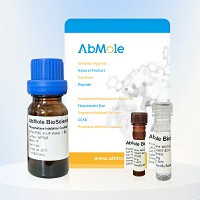All AbMole products are for research use only, cannot be used for human consumption.

Species: Human
Expression system: E.coli
Purity: greater than 85% determined by reducing SDS-page
Endotoxin: less than 0.001 ng/ug (0.01 EU/ug) as determined by LAL
Storage and stability: Lyophilized proteins should be stored at < -20°C but can be stored at room temperature for up to 3 weeks. The recombinant protein solution can be stored at 4-7℃ for 2-7 days. The isometric solution of the recombinant sample was stable at < -20°C for 3 months.
Biological activity: NRG1 (pro-neuregulin-1, Neuregulin-1 beta 1) is a single-pathway type I membrane protein belonging to the Neuregulin family, which contains an EGF-like domain and an IG-LIKE C2 (immunoglobulin like) domain. The direct ligand of ERBB3 and ERBB4 tyrosine kinase receptors. This protein recruits both ERBB1 and ERBB2 co-receptors, resulting in ligand-stimulated tyrosine phosphorylation and activation of ERBB receptors. Multiple subtypes have multiple functions, such as inducing the growth and differentiation of epithelial cells, glial cells, neuronal cells and skeletal muscle cells; The expression of acetylcholine receptors in synaptic vesicles during the formation of neuromuscular junctions stimulates alveolar budding and lactation induces differentiation of breast tumor cells and stimulates proliferation of Schwann cells. Associated with cardiac muscle development, such as trabecular formation of the developing heart. Isoform 10 May play a role in the development of motor and sensory neurons.
| Solubility (25°C) | It is not recommended to reconstitute to a concentration less than 100 μg/ml. |
| Storage |
Powder -20°C 3 years ; 4°C 2 years In solvent -80°C 6 months ; -20°C 1 month |
| Related Cytokines and Growth Factors Products |
|---|
| Recombinant Human GDF-15 Protein (HEK293 N-hFc)
Growth-differentiation factor 15 (GDF15), also known as MIC-1, is a secreted member of the transforming growth factor (TGF)-β superfamily. GDF-15 has a role in regulating inflammatory and apoptotic pathways in injured tissues and during disease processes. GDF-15 overexpression arising from an expanded erythroid compartment contributes to iron overload in thalassemia syndromes by inhibiting hepcidin expression. |
| Recombinant Human FGFR1 Protein (HEK293, C-His)
FGFR1, also known as CD331, is a full-length representative protein consists of an extracellular region, composed of three immunoglobulin-like domains, a single hydrophobic membrane-spanning segment and a cytoplasmic tyrosine kinase domain. |
| Recombinant Human FGFR2 Protein (HEK293, C-His)
FGFR2, also known as CD332, acts as cell-surface receptor for fibroblast growth factors and plays an essential role in the regulation of cell proliferation, differentiation, migration and apoptosis, and in the regulation of embryonic development. FGFR2 plays an essential role in the regulation of osteoblast differentiation, proliferation and apoptosis, and is required for normal skeleton development. It also promotes cell proliferation in keratinocytes and imature osteoblasts, but promotes apoptosis in differentiated osteoblasts. |
| Recombinant Mouse BMP-4 Protein (E. coli, C-His)
Bone Morphogenetic Protein-4 (BMP-4) is a critical signaling molecule required for the early differentiation of the embryo and establishing of a dorsal-ventral axis. BMP-4 is secreted from the dorsal portion of the notochord, and it acts in concert with sonic hedgehog to establish a dorsal-ventral axis for the differentiation of later structures. |
| Recombinant Human Coagulation Factor X (HEK293, C-Fc)
Coagulation factor X, belongs to the peptidase S1 family. Coagulation factor X is initially synthesized in the liver. Coagulation factor X is a vitamin K-dependent glycoprotein that converts prothrombin to thrombin in the presence of factor Va, calcium and phospholipid during blood clotting. |
All AbMole products are for research use only, cannot be used for human consumption or veterinary use. We do not provide products or services to individuals. Please comply with the intended use and do not use AbMole products for any other purpose.


Products are for research use only. Not for human use. We do not sell to patients.
© Copyright 2010-2024 AbMole BioScience. All Rights Reserved.
